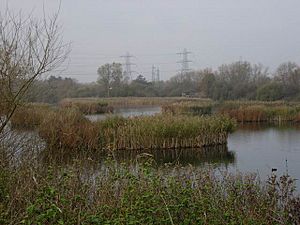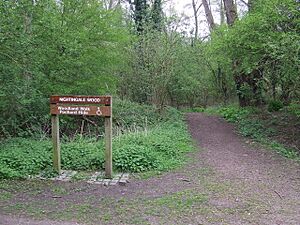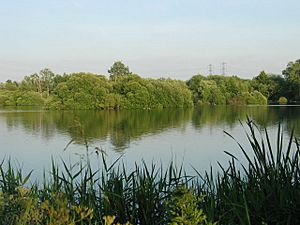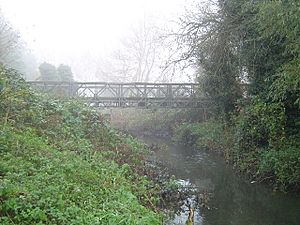Turnford and Cheshunt Pits facts for kids
| Site of Special Scientific Interest | |

The great bittern watchpoint, Seventy Acres Lake, Fishers Green
|
|
| Area of Search | Hertfordshire Essex |
|---|---|
| Interest | Biological |
| Area | 173.3 hectares |
| Notification | 1995 |
| Location map | Magic Map |
The Turnford and Cheshunt Pits is a special natural area located near Cheshunt in Hertfordshire and Essex. It's a "Site of Special Scientific Interest" (SSSI), which means it's protected because of its important plants, animals, or geology. This area covers about 173 hectares (that's like 428 football fields!). It's also part of the Lee Valley Special Protection Area, which helps protect wild birds.
Contents
Where is Turnford and Cheshunt Pits?
This amazing natural area is mostly owned by the Lee Valley Regional Park Authority. They manage it as part of the River Lee Country Park. The site is located next to the towns of Cheshunt and Turnford on its west side. To the east, you'll find Fishers Green and Holyfield.
What Makes This Place Special?
This SSSI includes ten old gravel pits. These are big holes left behind after gravel was dug out of the ground. The site also has parts of the Small River Lea, which is a smaller river. There's even a special water area called Hall Marsh Scrape, built just for waterfowl like ducks and geese.
Besides the water, you'll find different types of land here. There are marshy areas, open grasslands, and places with wild herbs. You can also explore scrubland (areas with small trees and bushes) and woodlands.
The Gravel Pits: A Look Back
The gravel pits were dug out over many years. Some, like the North Metropolitan Pit (also called Northmetpit), were created in the 1940s. Others, like Hooks Marsh Lake, were dug in the 1970s. This means the pits were formed over more than 40 years!
Amazing Birds You Can Spot
Turnford and Cheshunt Pits is super important for birds. In winter, it's a national hotspot for gadwall and northern shoveler ducks. It's also a regional home for wintering coots. You might even see snipe and the rare bittern here in winter.
When it comes to breeding birds, many species call this place home. Look out for the great crested grebe, tufted duck, coot, and little ringed plover. Smaller birds like the sedge warbler and reed warbler also raise their families here.
Tiny Creatures: Insects and More
This site is a paradise for small creatures without backbones, called invertebrates. Many types of aquatic (water-living) invertebrates have been found here. It's especially famous for its damselflies and dragonflies. You might even spot the rare hairy dragonfly, which breeds here. The red-eyed damselfly is also very common.
Wonderful Water Plants
The different pits are home to a variety of water plants and plants that grow along the edges. One special plant is the whorled water milfoil, which is rare in the UK. Other plants you might see include the fan-leaved water crowfoot, flowering rush, and lesser reedmace. You can also find frogbit, blunt-leaved pondweed, lesser pondweed, and the brown sedge.
Woodlands and Scrubland
Many of the narrow strips of land and islands in the pits have grown into areas of scrubland and woodland. These are mostly filled with different types of willow trees and alder trees.
To the west of the North Metropolitan pit is a large forest called Nightingale Wood. This woodland is a great place for passerine birds (perching birds) to rest and find food, especially in winter or when they are migrating. The rare musk beetle, Aromia moschata, also lives in these areas.
Grasslands and Creepy Crawlies
Some areas that used to be gravel pits are now marshy or have tall, wild grass. These spots are very important for invertebrates, especially near a place called Bowyer's Water. Here, you can find many grasshoppers and bush-crickets.
Experts believe the variety of grasshoppers and bush-crickets here is the best in Hertfordshire! Some species found here, like the lesser marsh grasshopper and the rare roesel's bush-cricket, are usually found closer to the coast.
Unique Plants on Reclaimed Land
Some of the old gravel pits were filled in with ash from power stations. This ash was often brought to the site by barges on the River Lee Navigation. This reclaimed land doesn't drain well, and the ash makes the soil very chalky.
Because of this special soil, the area has some of the biggest groups of marsh orchids in Essex and Hertfordshire. You can also find many early marsh orchids and southern marsh orchids. In smaller numbers, there are common spotted orchids and different mixed types of these orchids.
Ancient Grasslands
In the northern part of the site, at Turnford Pit North, there are small patches of grassland. These are thought to be parts of the original habitat that existed before the gravel was dug out. These untouched grasslands are dry and chalky, which is rare for a river valley. Here, you can find plants like the cowslip, wild carrot, and the common centaury.
Other Animals Living Here
The site is also home to many different mammals, reptiles, and amphibians. You might be lucky enough to spot an otter or tiny harvest mice. There's also a large group of grass snakes living here.
How to Visit Turnford and Cheshunt Pits
The closest train station is Cheshunt railway station. If you're coming by car, there's parking available right next to the site. You can also get there by cycling or walking along the Lea Valley Walk. Many public footpaths and cycle tracks let you explore a large part of this amazing natural area.
Images for kids






